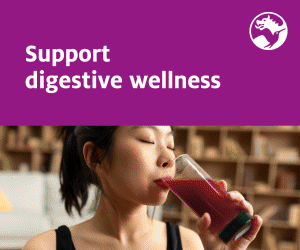There has been a lot of controversy in the media regarding krill oil and omega-3s. However, healthcare professionals’ belief in omega-3 benefits has remained constant, and they continue to recommend it as a dietary supplement.
As per the survey results published by Holistic Primary Care (HPC), 95% of US health practitioners recommend omega-3 to provide a wide range of positive health benefits, including heart health (82%), reduced inflammation (81%), brain and mood health (80%), joint health (65%), general well-being (61%) and prenatal health (48%).1
The 362 survey respondents comprised physicians, nurses and ancillary healthcare professionals. Traditionally, fish oil has dominated as the source of omega-3s. Krill oil is the second largest omega-3 category and, in terms of sales, it has been the top-selling dietary supplement in the mass market for the past few years.2,3
Krill oil is a fairly new player in the omega-3 market, but its chemical structure, lower level of omega-6 and lower risk of heavy metal contamination, makes it an extremely popular choice for consumers. An investigational study has also shown that krill oil has approximately twice the bioavailability of fish oil, making it easier for consumers to get the desired amount of omega-3s in smaller doses.4,5
Structurally sound
It is the chemical structure of krill oil that makes it unique. In fish oil, the omega-3 fatty acids eicosapentaenoic acid (EPA) and docosahexaenoic acid (DHA) naturally exist in triglyceride form, in which three fatty acids are attached to a glycerol backbone. In krill oil, EPA and DHA exist as phospholipids with a choline head group (Figure 1).6
It is this chemical structure that gives krill oil products the properties that make it particularly desirable to consumers. One of the most unpleasant side-effects of fish oil is the tendency to cause 'fish burps.' As the omega-3 fatty acids in triglyceride form in fish oil do not mix well with the contents of the stomach, they remain on the surface, resulting in reflux and a fishy aftertaste.
In contrast, the phospholipid-derived omega-3s in krill oil are more dispersible in water, and immediately mix with stomach fluids, thus reducing the occurrence of fish burps. Choline, the head group in krill oil omega-3 phospholipids, is the precursor for the neurotransmitter acetylcholine, which is involved in multiple memory and muscle control functions and assists in the transport of lipids.
Krill oil gets its deep red colour from astaxanthin, a powerful antioxidant that may help protect the cell membrane by neutralising free radicals. Astaxanthin has anti-inflammatory properties and is one of the very few antioxidants with the ability to cross the blood-brain-barrier. Krill oil tends not to contain omega-6 fats; an added advantage, as it helps to maintain the overall balance of omega-3 and omega-6 in the body (omega-6 is already abundant in the western diet).
Krill is also sustainable and the krill harvest is well within the safe levels established by third-party monitors. Additionally, krill oil’s place on the bottom of the food chain, along with its deep sea harvest location, makes it a clean source of omega-3s, without having to go through as many molecular distillations and refining steps as fish oil to be free from heavy metal contamination.
Benefits and properties
Lena Burri, PhD, Director of Scientific Writing at Aker BioMarine Antarctic AS, the leading supplier of krill oil has commented: 'Multiple animal studies have been conducted to gain insight into the potential of krill oil in conditions such as obesity, depression, myocardial infarction and chronic low-grade and ulcerative inflammation. There are many health segments in which krill oil may have specific benefits and it warrants further clinical investigations.'
When it comes to supplements, consumer acceptance is key to winning market share. Softgel capsules may enhance consumer acceptance for krill oils by incorporating multiple appealing features. 'Our red krill oil softgels have a high level of consumer acceptance because they are small and easy-to-swallow,' adds Dr Burri: 'Krill oil’s organoleptic properties makes odour masking a must have to appeal to consumers. In hard shell capsules, odour masking is a challenge as the hard shells are commercially pre-made and usually don’t contain flavours. Softgels are hermetically sealed, and additional odour masking can be incorporated very easily by adding flavours into the shells, and also within the fill.'
When it comes to supplements, consumer acceptance is key to winning market share
In addition to odour masking, softgel shells provide better stability for krill oils. Hard shells have air pockets that can make krill oil prone to oxidation. The hydrophilic nature of krill oil causes it to absorb moisture and plasticiser from the hard shell, making it brittle. Therefore, krill oil in a conventional hard shell may cause it to become brittle with time and leak. Krill oil is a natural fit for softgels, as softgels are the preferred way to deliver oils, solutions or suspensions. Hard shells are mainly designed for powdered formulations.
When asked to rank the selection criteria for choosing omega-3 products, the HPC survey participants selected fatty acid composition, organic, non-GMO and ease of compliance as the top factors. Krill oil in a softgel can be softer and easier to swallow, and this can result in better compliance. Softgels offer customisable design in terms of various shapes and sizes, which can make them more aesthetically appealing. This can positively affect the consumer acceptance and can result in better commercial success. Unlike hard shell capsules, softgels do not contain air pockets, which enables smaller sized dosage forms and correspondingly higher fill levels.
Throughout the supplements industry, softgels are known to enhance the bioavailability of nutritional compounds. It has been established that the faster release of compounds from softgels and rapid rate of absorption often results in enhanced bioavailability.7
Quality counts
An important factor in establishing consumer trust in a brand is the consistent quality of the dietary supplement. It is commonly accepted that quality can pave the way toward brand loyalty and helps companies to maintain their market position. The right partner is therefore an important element for a marketer of high quality products, but finding an external partner with the appropriate knowledge and technology has always been a business challenge when launching new products.8
Many industry experts agree that with the recent contradictory press regarding omega-3’s potential benefits, there is a need to educate consumers about the new scientific research on krill oil and the sustainable harvesting practices.9 The HPC survey also pointed out the need to educate healthcare practitioners and encourage them to act as a channel for omega-3 and krill oil supplementation.
There is a need to educate consumers about the new scientific research on krill oil and sustainable harvesting practices
When the health practitioners were asked to rate their knowledge on different sources of omega-3s, more than half of the participants considered themselves 'very knowledgeable' on fish oil as compared with a mere 23% on krill oil. Nearly one third of the participants accepted that their knowledge on krill oil was 'limited.' Educating end-consumers and health practitioners can result in an increased market size for krill oil.
Advances in formulation
Krill oil and the omega-3 industry can also benefit from newer formulation technologies such as enteric coating, plant-based softgel capsules and chewable softgel technologies. The enteric coating stops the softgel from dissolving in the stomach, enabling it to release its contents directly in the intestines where absorption is more effective. This can further minimize any issues with reflux and make the product more palatable for a wider population.
Furthermore, emulsification can also improve the bioavailability of the product. The emulsions are usually formed with particle size dispersions of less than 100µm. These capsules can be formulated as a taste masked delivery system, which can also be pierced, releasing the colloidal particles inside to be spread on food or drinks. Potential applications include products for paediatric and geriatric populations that have trouble swallowing softgel capsules.
The technology also exists to create chewable krill oil softgels, presenting krill oil products in a form that is more appealing to children, adolescents and older consumers. Incorporating omega-3 and krill oil in a chewable form can be tricky, as there are several formulation challenges that need to be overcome if the products are to pass consumer palatability tests and achieve commercial success.
The shell needs to be sufficiently robust to be stable in a wide range of temperature and humidity levels, but should also break down easily on chewing. The shell composition should be carefully selected to be compatible with the API, sweetening and flavouring agents. Catalent’s EasyBurst chewable technology, for example, is a novel technology that has overcome formulation challenges to balance the organoleptic and stability criteria for omega-3s. This technology can be further developed to encapsulate krill oil.
Another brand differentiation tactic for krill oil products is the use of printed softgels. Various patterns on the softgels can make the supplement more appealing to children, especially if printing and chewable characteristics are combined. Catering to the needs of consumers with dietary and religious restrictions can also increase the market potential of omega-3s. For instance, plant-based softgels such as Catalent’s VEGICAPS are made from all-natural, plant polysaccharide-based shells, which are more stable than gelatin-based shells with a wider variety of compounds.
The novel product forms can result in renewed consumer interest in omega-3s. Innovations in softgel technologies may offer consumer-centric products that can result in a robust and diverse product pipeline for krill oil and omega-3s in general.
References
1. Holistic Primary Care, 'How Do Dietary Supplements Fit into your Clinical Practice? News for Health & Healing (2014): www.nutraceuticalsworld.com/contents/view_breaking-news/2014-08-08/survey-polls-healthcare-professionals-on-supplements-omega-3s.
2. Engredea, Deep Dive Omega-3s: New Ingredients, New National Campaign Signal Hope in the Segment (2015): http://newhope360.com/omega-3-deep-dive.
3. SPINS/IRI (2013-2015): www.spins.com.
4. S.M. Ulven, et al., 'Metabolic Effects of Krill Oil Are Essentially Similar to Those of Fish Oil But at Lower Dose of EPA and DHA, in Healthy Volunteers,' Lipids 46(1), 37–46 (2011).
5. V.R. Ramprasath, et al., 'Response to Commentary on a Trial Comparing Krill Oil versus Fish Oil,' Lipids Health Dis. 22, 13–17 (2014).
6. B. Winther, et al., 'Elucadation of Phosphatidylcholine Composition in Krill Oil Extracted from Euphausia superba,' Lipids 46(1), 25–36 (2011).
7. D.H. Bergstorm, S. Tindall and W. Dang, 'Capsules, Soft' in J. Swarbrick (Ed.), Encyclopedia of Pharmaceutical Technology, Third Edition (Taylor & Francis, UK, 2006) p 419.
8. Catalent Applied Drug Delivery Institute, 'The 3rd Annual Drug Delivery Landscape,' www.drugdeliveryinstitute.com (2015).
9. R. Wright, 'Krill: Sustainably Harvested, Nutrient-Dense,' Supplyside Omega-3 Insights (April 2015, pp 17–21): www.tharos.biz/wp-content/uploads/2015/05/Krill-Sustainably-Harvested.pdf.




